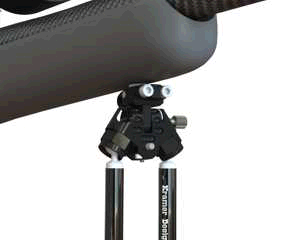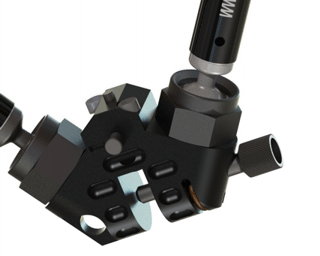

Most shooters are familiar with the Harris bi pod that has been available for the past 40+ years. The Harris bi pod design roots go back to the military bi pod designs of World War I, and in particular the Garand bi pods of that era. It is characterized by high weight, steel construction, external springs, noisy deployment, and limited panning capabilities. But it provides rock solid stability under favorable conditions.
In the mid 1980s, I purchased a 27"-S sitting model Harris for use on my 7mm mag mountain rifle. The first time I used it was on a Montana antelope hunt. As luck should have it, I ended up with a shot on a trotting antelope, broadside at about 175 yards. I attempted to shoot from the sitting position, but my Harris was incapable of panning with this moving target, so I quickly stood up to take the shot free hand. After touching off the first shot, I drove one of the metal side plates of the Harris deep into the knuckle of my index finger on my left hand. After two more shots, the blood from the knuckle wound was running down my forearm and dripping from my elbow. When all the excitement ended and I saw the blood on the toe of my boot and surrounding ground. I had an epiphany moment... I realized that there was a need for a bipod that could be quickly disconnected and connected.
As an avid shotgun shooter, I also noticed that the weight of my Harris significantly changed the way my mountain rifle swung and handled. My particular Harris bipod weighed 22 ounces, which on a 8 pound rifle is a significant percentage of the total weight. And that weight was placed in the worst possible spot, at the muzzle. Based on laws of physics, that 22 ounces is actually considerable heavier do to leverage. That weight placement made my mountain rifle feel like a howitzer after a hiking in the mountains.
I also noticed that if I sighted my rifle in naked, and then added the Harris weight after later, it would significantly lower the bullet point of impact down range. (Refer to my article of barrel bang time to further dig into this phenomena). To accommodate this I was forced to permanently leave the bipod on the front of my mountain rifle, and required me to sight in the firearm with the Harris on.
After several more hunting trips, the weight of the Harris became unbearable. It also was extremely uncomfortable slung over my shoulder. Finally I retired it, re sighted in my rifle and went in a different direction.
The Harris bipod is a great tool for urban SWAT applications where shooting on hard, slick surfaces is common, but for mountain hunting it just seemed out of its design elements.
Still in need of shooting aid, one that did not carry all the negatives of my Harris, I started to experiment with homemade shooting sticks.
Using my computer I determined the inside diameter and outside diameter of every Easton Aluminum XX75 arrow shaft that was on the market. I soon discovered two shaft sizes that would tightly nest inside each other. I just happened to have a large collection of old arrows, and several in the size I needed. With very little effort, I produced my first fold up, shooting stick.
I loved my shooting sticks, and thought they were a significant improvement over the Harris for my hunting demands. They were tall enough to shoot sitting with, they were very light weight, and they folded small enough to fit into a pocket. However, they came with their own list of negative issues.
When designing the SnipePod V2, I established the following short list of goals.
 |  |
| Ultra fast installation/removal at the moment of need! | Over 80° of movement in each ballsocket |
On another hunting trip, I had another epiphany, I came up with the thought of attaching each leg independently via ball sockets to a common assembly that in turn could be quickly and easily attached to my rifle. Leveraging my experience with Computer Aided Design (CAD), I quickly raced through many generational improvements resulting in the product as shown in this website. Final design created a ball socket that provides over 80° of leg movement!
The SnipePod V2 design achieved all the original goals I set out, and even went beyond by introducing the concept of independent legs. Each leg can be strategically placed around any type of ground obstacle, without affecting the other leg. You can independently place leg(s) around rocks, cactus, trees, or even span large crevices (such as would be encountered in talus boulder fields in alpine terrain). It is easy to see the similarities of the SnipePod V2 to the hip sockets at the top of each of our legs in the human body.
For side hill adaptation, one leg can be placed vertical, while the other can be placed horizontal to accommodate the incline.
All of the sitting models weight 5 ounces! The two prone models are 2 ounces!
When folded for carrying, the sitting and prone models are all under 8 inches in total length. The mounting device that remains on the firearm (V2-QDMT) is small, and light as a feather. The V2-QDMT weights only .25 of an ounce (or 105 grains if you want to compare it to the weight of a bullet). You will have no problems slipping your rifle into and out of a horse/ATV scabbard, or fitting it into any gun case.
The ball sockets provide 80 degrees of canting, over 90 degrees of vertical panning, and over 180 degrees of horizontal panning. The panning is smooth and quiet. In fact, in order to actually use the total available horizontal panning capability, the shooter would have to pickup and reposition their sitting location at least 5 times! That is the flexibility of the ball socket design.
Beside the incredible ability to adapt to difficult terrain, the panning ability can be looked at from a different perspective. The SnipePod V2 is unparalleled in its ability to allow the shooter to very quickly acquire or "lock in" on a target. Not only is it very fast to acquire a target for the first shot, it is just as quick to acquire that target for follow up shots. Every shot, 1st, 2nd, 3rd, etc.. can effectively be taken with the rock solid confidence provided by the SnipePod V2. This is referred to as "recoil recovery time".
The ball sockets are adjustable for tension. They are set just tight enough at the factory so that the legs will maintain their position if the firearm/SnipePod V2 is lifted off the ground. However, the tension is not too tight that it has any effect on the "smooth as glass" feel to the panning capabilities of the SnipePod V2. Adjusted like this, the shooter can quickly and easily pick up the firearm (with one hand), pivot or change positions. Then as soon as the feet of the SnipePod V2 hit the ground, that incredible panning ability comes into play to allow lightening quick target acquisition.
As remarkable as the SnipePod V2 is, there is one rule that must be followed. The SnipePod V2 design is based on the principle of strength inherit to a triangle. Two of the sides of the triangle are the legs of the SnipePod V2. The third leg of this triangle is the ground or supporting surface between the two contact points of the SnipePod V2 feet. As long as the feet have solid grip, the triangle works. However attempting to set the SnipePod V2 on smooth slick surfaces will not allow the triangle to form, and the SnipePod V2 will not "lock in". This eliminates smooth ice, tile floors, and the hoods of most pickup trucks. However, if you are a field hunter, you will not find this a limitation.
So if you are a serious hunter, and if you put in the miles, no other shooting support even come close to the flexibility and adaptability of the SnipePod V2. It must be experienced to be appreciated!